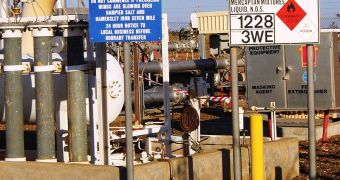The Environmental Protection Agency thinks there is a strong connection between controversial fracking techniques, also known as hydraulic fracturing and the high levels of water pollution.
Representatives from the organization reached this conclusion after monitoring the level of contamination of grown water in Pavillion, Wyo. To their surprise, EPA experts have identified an alarming amount of benzene, synthetic glycol and alcohol, usually spotted in fracking fluid, NPR reports.
It is the first time when an eco-friendly agency suggests that this kind of operations can be responsible for water contamination.
Even though hydraulic fracturing is a disputed technique rejected by many eco-conscious activists and organizations, so far nobody managed to prove with exact numbers and statistics the real contribution of such operations to environmental degradation.
Somehow, EPA is convinced that fracking activity can contaminate drinking water. The agency says it is quite explainable, since companies pump chemicals underground to blast fractures in order to liberate natural gas.
Although experts have warned this technique poses environmental risks, president Obama is a keen supporter of this kind of operations, due to their noticeable financial benefits.
EPA states it was called by Pavillion inhabitants three years ago, to investigate the problem. Inhabitants complained about their water, saying it smelled and tasted bad. It appears that this is not an isolated case, since many local communities developing hydraulic fracturing projects have been contaminated so far.
Recent samples of water reveal a high level of toxic compounds that can be easily linked to fracking operations. As a response, Encana, the company behind this potential major source of pollution rejected EPA's research and stated it was based on mere “speculations.”
On the other hand, the agency is keen on proving them wrong and says it is likely that drilling operations expose local people to dangerous sources of water pollution.
"Alternative explanations were carefully considered to explain individual sets of data. However, when considered together with other lines of evidence, the data indicates likely impact to ground water that can be explained by hydraulic fracturing," note EPA officials.
However, their research is not complete and they are still gathering all the information to prove the disturbing connection. At this point in time, the main priority seems to find a more risk-free source of drinking water for the people living in Pavillion.

 14 DAY TRIAL //
14 DAY TRIAL //